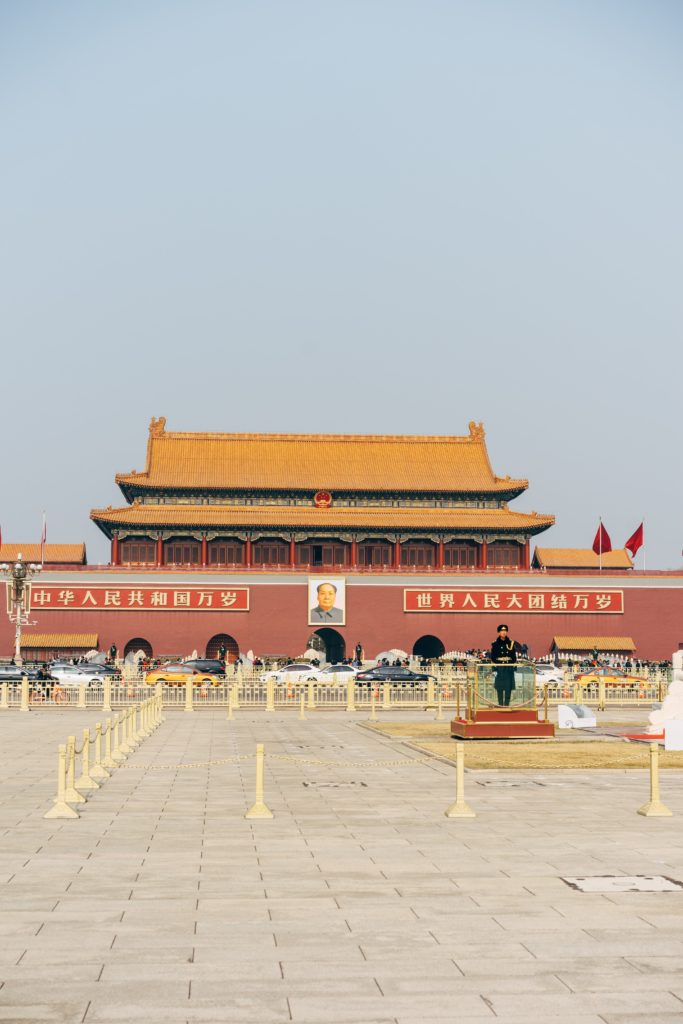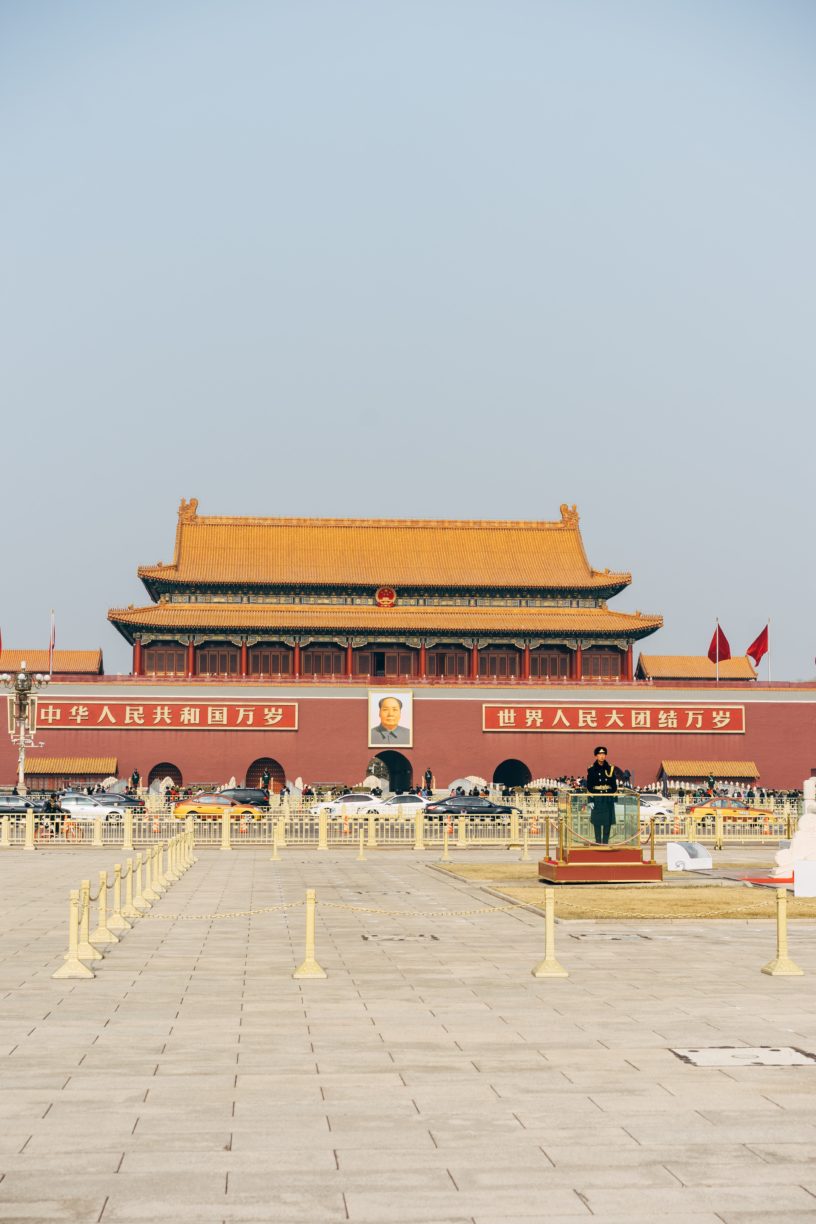
Photo of Tiananmen Square by Markus Winkler on Unsplash
Top 10 Historical Facts about Tiananmen Square
Tiananmen Square, also known as Tiananmen Guangchang, is located in Beijing, the capital city of the People’s Republic of China. It is one of the most famous and largest open squares in the world covering over 100 acres.
While most people will probably identify the square for the famous protests that have taken place in it, there’s more to the square than just that. It has played host to landmark events in China and acted as a crucible for both cultural and political revolutions.
Tiananmen Square is magnificent in size and design. It sits in a neat symmetrical shape and is rich in ancient Chinese history.
Read more on the Top 10 Historical Facts about Tiananmen Square below
1. “Tiananmen” Means Gate of Heavenly Peace

Tiananmen Square by Dong CY from Pixabay
The square traces its origins to the Ming Dynasty. It was built in 1415 as a gate in the wall of the Imperial City, the so-called Forbidden City (Read more on The Forbidden City in China). Emperor Zhudi and Emperor Yongle constructed the Tiananmen gate.
During the reign of the Ming and the Qing dynasty, the City’s gate was damaged.
Hence the square was later redesigned and contains several important monuments and buildings such as the Great Hall of the People, the Monument to the People’s Heroes, the National Museum of China, and the Chairman Mao Zedong Memorial Hall.
It holds great cultural significance for China, having been the site of several historical events.
2. The purpose of building the Tiananmen gate was to keep off intruders
The Chinese emperors who built the Tiananmen gate did so to protect themselves and their courts.
However, during the Ming and Qing dynasties, the southern gate to the Forbidden City (Gate of China) was demolished in 1954 to expand Tiananmen square.
3. The Chinese cosmological order of “qi” (chi) informed the design of the square
The emperor’s throne at the center of the Forbidden City palace was the main focus of traditional Beijing.
Therefore, to re-center the city to Tiananmen square and enable the flow of Chi, the design flipped the primary axis of the city from north-south to east-west orientation. This also shifted the focal point southward towards the intersection of Chang’ an Avenue and Tiananmen.
4. The square’s area was originally a quarter of its current size
Tiananmen Square was built in 1651. It was a quarter of the size it currently represents.
Over the years it progressively underwent an expansion to increase its size to close to 100 acres of land.
5. Tiananmen Square is strategically located at the Heart of China’s culture

Palace of Heavenly Purity in the Forbidden City in Beijing – view from Jingshan Park. Photo by Reinhold Möller. Wikimedia Commons
Tourists and locals in China look forward to visiting the Square in Beijing as it is home to numerous cultural artifacts and important landmarks.
As more than 500 years passed, Tiananmen Square became a diamond in the crown of Beijing. It witnessed how Chinese people struggled against feudal governance and foreign invaders for democracy and freedom.
Tiananmen Square now stands as a symbol of the national cohesion and prosperity of China.
6. Mao Zedong proclaimed the establishment of the People’s Republic of China at Tiananmen Gate

Image by PublicDomainPictures from Pixabay
In 1949, CCP won the civil war and on 1st October 1949, Chairman Mao proclaimed the establishment of the People’s Republic of China at Tiananmen Gate. Thereafter, Mao shared his vision of having a square at Tiananmen that would be big enough for every single person in China!
His body was later embalmed in a Mausoleum at the square known as Mao Zedong Memorial Hall.
7. Over 11 million people visited Tiananmen Square in its first months of opening
For ten years, beginning in 1949, on the anniversary of the founding of the People’s Republic of China there were large military displays at Tiananmen Square.
Nowadays, The Great Hall of the People in Tiananmen Square plays host to the annual National People’s Congress meetings. It has more than 10,000 seats in the meeting hall and 5,000 more in the banquet hall.
8. It has played host to important ceremonies in the imperial and communist eras

Policemen marching at Tiananmen Square, China. Photo by Hennie Stander on Unsplash
Visitors to Tiananmen square enjoy a free lesson on China’s history.
During the imperial eras, the gate formed part of a ceremonial axis that started at the southern tip of the city of Beijing. From there, the axis led past the most important temples and through numerous gates like Chengtianmen and Tiananmen to the Hall of Supreme Harmony, where the most important imperial ceremonies took place.
During the Mao era, events such as Pageants and National Day Parades used to be held at the square. However, it is no longer compulsory to attend such events held at the square.
Locals and tourists frequently visit the square to witness the meticulous flag-raising ceremony done every day.
9. 1989 Tiananmen Square protests drew international attention following the massacre

30th anniversary of the 1989 Tiananmen Square Massacre. Photo by Suiren2022. Wikimedia Commons
The 1989 Tiananmen Square protests made the square famous. The death of Hu Yaobang -a former Communist Party leader triggered the student-led demonstrations.
However, people from all walks of life joined the protests at Tiananmen Square. In total, more than one million people came out in support of the protests. Subsequently, images from the events drew international attention.
The Chinese government later brought the protests to an end on June 4th and June 5th, 1989 through a crackdown popularly known as the Tiananmen Square Massacre. During the massacre, thousands of protesters escaped though few fought back the attacking troops. The famous Tiananmen Square Tank Man was photographed as he tried to block a military tank at the square. However, his identity remains unknown.
These protests remain a dark spot in the history of Tiananmen square.
10. Through the Monument to the People’s Heroes, China’s patriots are immortalized

Monument to the People’s Heroes, on Tiananmen Square, Beijing.Photo by Daniel Case. Wikimedia Commons
This epic monument stands at a height of 37.94 meters.
Its front section has an inscription with the words: “Immortal People’s Heroes” – spoken by Mao Zedong. While at the back there’s also an inscription written: “Glory forever”.
This grandeur monument reflects the tremendous contribution of revolutionary martyrs and people’s strong homage to them.
Tiananmen Square is not just a historical area but it is also a modern-day site for casual, leisurely activities. Therefore it is no surprise to see people flying kites at the square or even locals exchanging notes about their pet grasshoppers!
Practical information:
to enter the square One needs a passport.
It gets quite hot even in the early evening due to the concrete.
During the Mid-Autumn Festival Holiday, the flower displays make a wonderful experience.
Planning a trip to Paris ? Get ready !
These are Amazon’s best-selling travel products that you may need for coming to Paris.
Bookstore
- The best travel book : Rick Steves – Paris 2023 – Learn more here
- Fodor’s Paris 2024 – Learn more here
Travel Gear
- Venture Pal Lightweight Backpack – Learn more here
- Samsonite Winfield 2 28″ Luggage – Learn more here
- Swig Savvy’s Stainless Steel Insulated Water Bottle – Learn more here
Check Amazon’s best-seller list for the most popular travel accessories. We sometimes read this list just to find out what new travel products people are buying.










